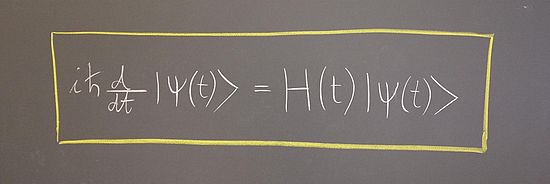
Research
Our research interests comprise quantum computing and quantum coherence, opto- and nanomechanics, quantum synchronization, superconductivity, and ultracold atom systems as well as the development of machine learning techniques for physics. We are a part of the Basel Quantum Center and collaborate with research groups in Basel, at other Swiss universities, and abroad. Our activities are integrated in the NCCR Quantum Science and Technology (QSIT).
Unsere Forschung (deutsche Zusammenfassung)
Mesoskopische Quantensysteme liegen von der Grösse her zwischen der mikroskopischen Welt (Atome und Elementarteilchen) und unserer Alltagswelt. Unsere theoretische Forschungsgruppe untersucht neuartige Quanteneffekte in solchen Systemen. Wir studieren z.B. die Wechselwirkung von kleinen mechanischen Schwingern mit Licht und elektrischen Strömen. Wir untersuchen ausserdem Quanten-Modellsysteme, die aus einer kleinen Zahl von supraleitenden Quanten-Bits, den Bausteinen eines Quantencomputers, bestehen. Diese Forschung führt zu neuem Grundlagenwissen, z.B. Erkenntnissen darüber, wie sich elektrische Leitfähigkeit oder thermische Leitfähigkeit verhalten, wenn die Systeme immer kleiner werden, und ist potentiell relevant für ultrasensitive Messmethoden.
Current research projects
Quantum optomechanics
Light exerts radiation pressure, however, the corresponding forces are often negligible. In optomechanical systems, they are strong and can be used to manipulate mechanical degrees of freedom, such as the center-of-mass motion of small cantilevers or membranes. We study optomechanical systems in the quantum regime and look for applications in quantum sensing.
Machine learning in physics
Data-driven methods are becoming of central interest in many scientific fields. We investigate how physical knowledge can be encoded in machine-learning algorithms based on the paradigm of differentiable programming. Potential applications of these methods include quantum control and the estimation of parameters of a quantum system. We also study how novel physical phases can be discovered without prior knowledge about the phase diagram of the physical system.
Quantum synchronization
Synchronization of self-oscillators is a universal phenomenon that is important both in fundamental studies and in technical applications. Recent experimental progress in hybrid systems like trapped ions or superconducting circuits motivates the study of synchronization in the quantum regime. We investigate networks of coupled quantum self-oscillators with the goal to find novel quantum phenomena which are not present in the corresponding classical system.
Superconductivity
Superconductivity and superfluidity are fascinating macroscopic quantum phenomena. We study transport in hybrid system in which one part is superconducting and the other a normal metal (e.g., a 2-dimensional electron gas or a graphene layer). These systems give rise to novel quantum states and unconventional particle-like excitations (like Majorana quasiparticles). We are also interested in superconducting devices as building blocks in quantum information processing (arrays of superconducting quantum bits), in quantum thermodynamics, and other areas.
Quantum coherence and quantum measurement
Textbook-type "projective" measurements leading to the collapse of an initial state to the measured state are an idealization. We study generalized measurement protocols that can be applied to correlation measurements of non-commuting operators. In view of recent efforts to control and manipulate individual quantum systems, our results are guidelines for attempts to assess quantum processes in the least invasive way.
Ultracold atoms
Ultracold bosonic and fermionic atoms can be trapped by optical fields and used to probe phenomena like quantum phase transitions or quantum transport known from condensed-matter physics in new parameter regimes and with unprecedented parameter control. We are interested in time-dependent phenomena in optical lattices and in transport at intermediate interaction parameters along the crossover between a BCS superfluid of Cooper pairs and a Bose-Einstein fluid of tightly bound bosons.

